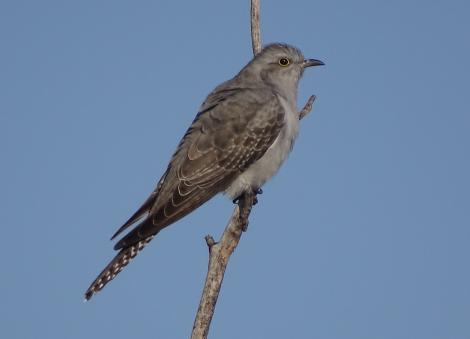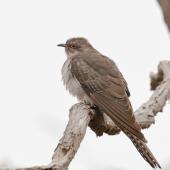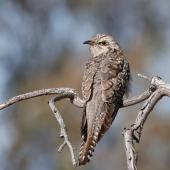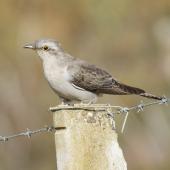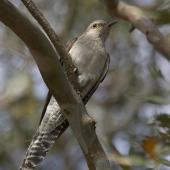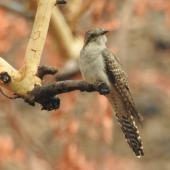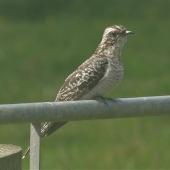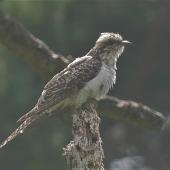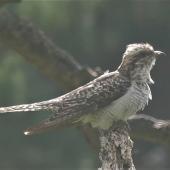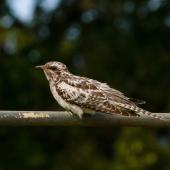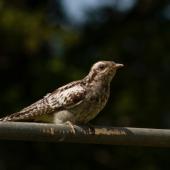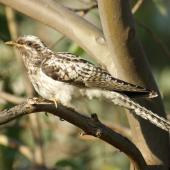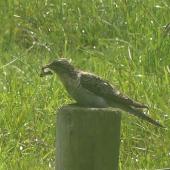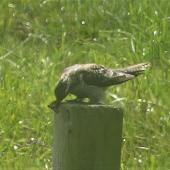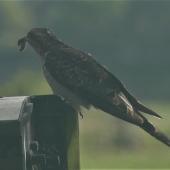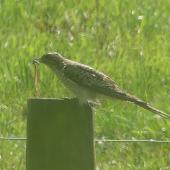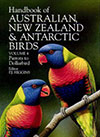Pallid cuckoo
Cacomantis pallidus (Latham, 1802)
Order: Cuculiformes
Family: Cuculidae
Other names: rain bird
The pallid cuckoo is an Australian-breeding migratory cuckoo that has been recorded in New Zealand on six occasions. The first bird visited the same central Otago farm for three consecutive years during the non-breeding season (May-October), from 1939 to 1941. Several New Zealand sightings have been during the November-January breeding season, with the most recent being at Otakeho, south Taranaki in February 2021. Like most cuckoos, the pallid cuckoo is conspicuous by its loud, repeated calls during the breeding season, but the bird itself is often difficult to locate.
Identification
The pallid cuckoo is a medium-large cuckoo with the falcon-like profile characteristic of all Cuculus cuckoos. There are several quite different plumage stages or morphs, none of which have the heavily barred underparts of the similarly variable oriental cuckoo, and all showing bold white spots to the edge of the uppertail when at rest. Most adult males are pale grey, darker dorsally, with a dark stripe through the eye, a white spot on the nape and boldly barred black-and-white undersides to the wings and tail. A few males are darker grey, with all gradations in between. Females are more rufous in colour, and also vary between light and dark extremes, all with bold chestnut mottling on the dark upperparts, and some with a band of chestnut barring across the breast. All adults have the white spot on the nape and a narrow yellow eye-ring. Juveniles are boldly streaked and spotted with dark brown and white on the back, and are grey below, with buffy barring on the breast.
Voice: males give a loud ascending whistle that can vary, with a series of slowly rising and accelerating melodic notes, “too, too...too, too”. The female has a hoarse ascending “wh-wh weeya wh-wh weeya”.
Similar species: the pallid cuckoo is most likely to be confused with the related oriental cuckoo, which is similar in size and shape, and has occurred in New Zealand about 36 times. The oriental cuckoo rarely calls when in Australia or New Zealand, and is much more heavily barred underneath than the pallid cuckoo. Oriental cuckoos also lack the white spots along the edge of the uppertail, which all pallid cuckoos have.
Distribution
The pallid cuckoo breeds in south-western and south-eastern Australia, migrating north after breeding to northern Australia, Papua New Guinea, Indonesia, Timor-Leste, Moluccas and Lesser Sundas. It is common in Australia, but a vagrant to New Zealand, no breeding records here.
Habitat
The pallid cuckoo mainly occurs in shrublands and lightly timbered country in Australia, including grasslands, farmland, and mallee bush. It is also found in urban parks and gardens, wherever its host species are present.
New Zealand records
First recorded at Craig Flat, Otago in May 1939 through to Oct 1941, and subsequently at Okarito, Westland (December 1941), Greymouth (March 1942), Wairarapa (1977), Omarama, Otago (January 1990), Karori, Wellington (November 2006), Rockville, Golden Bay (December 2019), and Otakeho, south Taranaki (February 2021).
Breeding
The pallid cuckoo breeds only in Australia, laying its eggs in nests of willie wagtails, honeyeaters, wood swallows, whistlers and flycatchers. Laying occurs from July to January in south-western Australia and August to November in south-eastern Australia. The female removes one of the host's eggs before replacing it with one of her own. Young pallid cuckoo chicks hatch before the chicks of the host, with the unhatched eggs being ejected.
Behaviour and ecology
Generally inconspicuous unless calling, pallid cuckoos sometimes perch in the open when foraging, e.g. on a fencepost, swooping down to the ground to catch insects and earthworms.
Food
Pallid cuckoos are mainly insectivorous; snatching their prey from foliage and from the ground. Like many other cuckoo species, they specialise on species of hairy caterpillars, which other birds generally avoid.
Websites
http://www.avianweb.com/pallidcuckoos.html
http://planetbirds.blogspot.co.nz/2010/11/pallid-cuckoo.html
References
Anderson, M.G.; Hauber, M.E. 2007a. A recognition-free mechanism for reliable rejection of brood parasites. Trends in Ecology and Evolution. 22: 283-286.
Anderson, M.G.; Hauber, M.E. 2007b. The cuckoos. Quarterly Review of Biology. 82: 156.
Davies N.B. 2000. Cuckoos, Cowbirds and other Cheats. Princeton University Press.
Heather, B.D.; Robertson, H.A. 1996. The field guide to the birds of New Zealand. Viking, Auckland.
Marples, B.J. 1941-42. Notes on cuckoos. Ornithological Society of New Zealand Reports & Bulletins 2: 73-74.
Payne, Robert B. 2005. The cuckoos. Oxford University Press, Oxford, England
Slater, P.; Slater, P.; Slater, R. 1986. The Slater field guide to Australian birds. Rigby Publishers, New South Wales, Australia.
Wilson, K. 2004. Flight of the huia – ecology and conservation of New Zealand’s frogs, reptiles, birds and mammals. Canterbury University Press, New Zealand.
Recommended citation
Seabrook-Davison, M.N.H. 2013 [updated 2021]. Pallid cuckoo. In Miskelly, C.M. (ed.) New Zealand Birds Online. www.nzbirdsonline.org.nz
Pallid cuckoo
- Breeding season
-
- Jul
- Aug
- Sep
- Oct
- Nov
- Dec
- Jan
- Feb
- Mar
- Apr
- May
- Jun
- Egg laying dates
-
- Jul
- Aug
- Sep
- Oct
- Nov
- Dec
- Jan
- Feb
- Mar
- Apr
- May
- Jun




